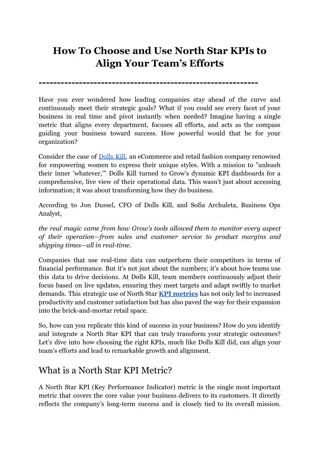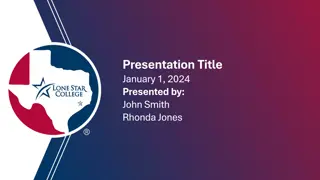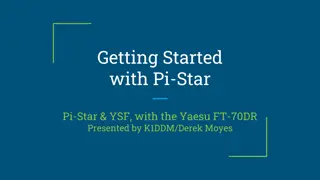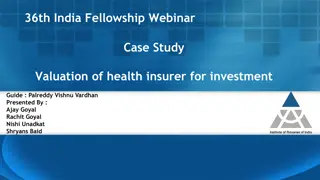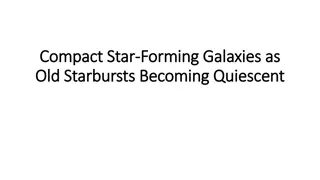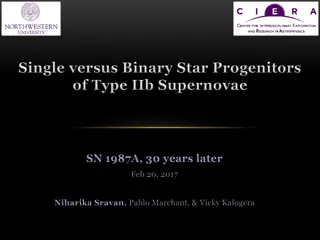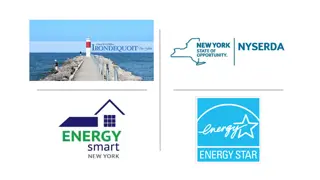
K*-(892) Meson Production in High-Energy Physics Research
Explore the A-dependence in K*-(892) meson production in high-energy physics, based on experimental data from K-N interactions at the U-70 accelerator complex. Results from the SPASCHARM experiment by Nikita Kalugin shed light on the inclusive production of K*-(892) mesons for different targets. Event selection criteria and detector analysis provide insights into nuclear targets and beam tracks. Don't miss the findings presented at the ICPPA 2024 conference in Moscow.
Download Presentation

Please find below an Image/Link to download the presentation.
The content on the website is provided AS IS for your information and personal use only. It may not be sold, licensed, or shared on other websites without obtaining consent from the author. If you encounter any issues during the download, it is possible that the publisher has removed the file from their server.
You are allowed to download the files provided on this website for personal or commercial use, subject to the condition that they are used lawfully. All files are the property of their respective owners.
The content on the website is provided AS IS for your information and personal use only. It may not be sold, licensed, or shared on other websites without obtaining consent from the author.
E N D
Presentation Transcript
. . K*-(892) meson production in 26.5 GeV/c K-N interactions at U-70 accelerator complex SPASCHARM EXPERIMENT Nikita Kalugin, NRC Kurchatov IHEP, Protvino, Russian Federation On behalf of the SPASCHARM collaboraltion ICPPA 2024 from the 22ndto 25thof October, 2024 VII International Conference on Particle Physics and Astrophysics Moscow, Russia
Introduction A-dependence is a traditional fundamental research topic in high energy physics. Up to now there are only scarce data on the A-dependence (for C and Cu targets) of K*-(892) meson (K*-(892) s0 -) production for 0.0 < xF< 0.8 and 0.0 GeV2/c2< pt2 2.4 GeV2/c2performed by WA89 Collaboration (CERN) in 345 GeV/c -A and -Ainteractions and in 260 GeV/c nA interactions. We report about results of A-dependence (for C, Al, Cu, W targets) in 26.5 GeV/c K-A interactions for inclusive K*-(892) meson (K*-(892) s0 -) production for 0.4 < xF< 1.0 and 0.0 GeV/c < pt 1.0 GeV/c ICPPA, 22-25 October 2024 (2) Nikita Kalugin (SPASCHARM coll.)
0production (reported in RAS session, April 2024) A-dependence of ?? 0.1 < pT 0.5, 0.5 < pT 0.9, 0 < pT 0.2, 0.2 < pT 0.4, 0.4 < pT 0.6, 0.6 < pT 0.8, 0.8 < pT 1.2, K-A -A /c /c /c /c /c /c /c 0.783 0.049 (pT) 0.695 0.026 0.642 0.048 (pT) 0.843 0.044 0.709 0.030 0.730 0.029 0.758 0.031 3.218/3 2/ndf 4.655/3 4.791/2 2/ndf 3.365/3 1.85/3 4.583/3 1.939/3 3 ., -2024,
The SPASCHARM Detector Nuclear targets location We have carried out analysis of the experimental data had been collected in 2022 ICPPA, 22-25 October 2024 (3) Nikita Kalugin (SPASCHARM coll.)
Event selection for K*-(892) s0- Multiplicity of beam tracks is equal to 1 Identified K At least one positive charged reconstructed track and at least two negative charged reconstructed tracks V0 were selected from all pairs of positive and negative reconstructed tracks which formed a vertex (decay point) in the decay zone: between Zdecay 31 cm and Zdecay 77 cm The distance between the two opposite tracks at the decay point had to be smaller that ~0.6 cm Rejection kinematical ranges corresponding to 0 p -decay and e+e-conversions Z-coordinate of the reconstructed primary vertex was required to coincide with the center of a target(~23cm for all targets) to within 3 standard deviations (~2.5cm) The cosine of the pointing angle, which corresponds to the angle between the V0momentum and the line connecting the secondary vertex to primary vertex, is required to be larger 0.98. 1. 2. 3. -beam track by 1, 2, 3Cerenkov beam counters 4. 5. 6. 7. 8. Clearly visible signal from s0 + - ICPPA, 22-25 October 2024 (4) Nikita Kalugin (SPASCHARM coll.)
Kinematic fitting for s0 + - Kinematic fitting is a powerful tool widely used in particle physics analyses, recognized for it s ability to improve the resolution of measured particle track Parameters, suppress background, reconstruct undetected particles and to determine the position of vertices. Our goal is to find an improved set of charged tracks parameters as close as possible to the true values (we need s0 s 4-momenta with high accuracy) For purely kinematic fit the charged track parametrization is follow: 1. Inverse momentum 1/p [MeV-1c] 2. Polar angle [radians] defined from 0 to . 3. Azimuthal angle [radians] defined from - to relative to the beam (z) axis 4. Covariance matrix, where the diagonal entries corresponds to the uncertainties in parameters 1/p, , ICPPA, 22-25 October 2024 (5) Nikita Kalugin (SPASCHARM coll.)
Kinematic fitting for s0 + - General formalism for kinematic fitting We have set of measured charged tracks parameters: 1/p, , and errors: 1/p, , We need to find improved set of charged tracks parameters and their corresponding errors, such they fulfill some kinematic or geometric constraints. This concept can be translated quantitatively into a 2minimization expressed as follow: 2 ???? ??? 1 ? + 1 + 2 2 ???? + ??? + ???? + ???? + ??? + ???? + ? 2= + + + ????1 + ? 2 ???? ??? 1 ? 1 2 2 ???? ??? ???? ???? ??? ???? ? + + ????1 ? Or shortly (matrix notation): 2= ? ? ? 1 ? 2 ?? 2 ?=1 2 ???? ?? with constraint (in our case) : ? = ?=1 2 2 ?? = 0 ICPPA, 22-25 October 2024 (6) Nikita Kalugin (SPASCHARM coll.)
Kinematic fitting for s0 + - General formalism for kinematic fitting This problem can be solved by the method of Lagrange multipliers. We should transform 2and constraint function into: ? = ? ? ? 1 ? + 2 ? ? Minimizing the Lagrange function (L) involves finding the derivatives of L with respect to unknowns and . By setting These derivatives to zero and subsequently solving for , the minimization can be achieved 2 2 2 2 1 1 1 1 ??? ???? + ???+ ??? ???? ??? ? = 2+ 2 + ?? + ?? ???? + ???? ??? ??? ??? ??? 1 ? 1 ? 1 ? 1 ? + + 2 2 1 1 1 1 ??? ???? + ???+ ??? ???? ??? ???+ ??? 2 ???? + ???? ???? + ???? ??? 0 ??? ??? ??? ??? 1 ? 1 ? 1 ? 1 ? + + As this problem is generally non-linear, an iterative procedure is employed, with each iteration yielding improved approximations for ICPPA, 22-25 October 2024 (7) Nikita Kalugin (SPASCHARM coll.)
Kinematic fitting for s0 + - General formalism for kinematic fitting ? = ? +? ? ? Taylor expansion of a function to linear terms ? ? ? =? ? ? ? ? ? ? +1= ? 1 ? ? ? ? ? +1updated measured parameters +1= ? ? ? ? ? ? 1? ? ? ? updated covariant matrix ? +1= ? For = 0 : 0= ? . After each iteration L calculated and results compared with the previous iteration. Iteration process stops when ? ? +1< 0.01 (Convergence criteria) ICPPA, 22-25 October 2024 (8) Nikita Kalugin (SPASCHARM coll.)
Kinematic fitting for s0 + - ?? 2( =1, 1C-FIT) value ??? 2 ???2= ?2 has relatively a uniform distribution for SPASCHARM experimental data ?? ? Pulls distributions(stretch function): ?????= a systematic error in the measurements of 1/p, , and 1/p, , defined correctly. is fairly close to N(0,1) and not asymmetric. So we don t have ?2?? ?2 ? ICPPA, 22-25 October 2024 (9) Nikita Kalugin (SPASCHARM coll.)
Kinematic fitting for s0 + - Results After 1C-Fit The mass peak is centered near the PDG K*-(892) mass value for all targets A slight increase in statistics at the peak for some targets ~6% improvement in the determination of the s0h- system invariant mass There is not visible background suppression Black filled histogram: invariant mass of s0h-system pre-1C-fit Red filled histogram: invariant mass of s0h-system post-1C-fit Red dashed line PDG K*-(892) mass. The results corresponds to events with confidence level 0.005 ICPPA, 22-25 October 2024 (10) Nikita Kalugin (SPASCHARM coll.)
Total statistics of K*-(892) s0- Invariant mass distributions have been fitted by the well-known formula: ?? ??= ?? ?? + ?? ?? 1 + ?1?? Assuming PS BG 144+/-12 367+/-19 ??(?) =? ? 2 2+ ?0 ? 2 2? ?2 ?0 BW(M) relativistic p-wave Breit-Wigner function with dynamical width: 2?+1? ? ? ?0 ? ? ? ?0 ? = 0 105+/-10 ? ? 1 93+/-10 ? ? ? - the momentum of the decay product in the rest frame of the resonance ? =1 orbital momentum. Any details see in J.D.Jackson, Nuovo Cimento 34 (1964) 76 ?3 ? ?4 ? ????? ?5 ? ?????2 ?? ? = ?2 ? ????? Background is described by a two terms, involving at most 4 free parameters, which take into account possible threshold effects and quasi-exponential background far from threshold mass ?????. Also taken into account experimental resolution in the invariant mass: ? ? ? ?0 2?+1? ? ? ?0 + 2 2 ?( s0 ) ? = 0
A-dependence 2 2 2 ??? ??? ??? ?? ?? ?? ?? 2+ ??? 2+ ?????? 2 ??? = ??? ???? ??????? ?? ? ????? ? ?? ? ?? ?? ?? ??? ????? ? ??? ??? ?????? ?? ?? ?? = ?? ????? ? ?? ? ?? ? ?? ??? ??? ????? ??? ?? ?? ?????? ??? ICPPA, 22-25 October 2024 (12) Nikita Kalugin (SPASCHARM coll.)
Stability of results checking Variations of background: ?? ? ?? ? ????? ?? ? ?????? ?? ? ?????? ?? ? = ?? ? ????? Alpha = 0.56 +/- 0.04 with 2/ ndf = 25.96/2 ?? ? ?? ? ????? ?? ? ?????? ?? ? = ?? ?? ????? Alpha = 0.59 +/- 0.04 with 2/ ndf = 14.09/2 ?? ? ?? ? ????? ?? ? ?????? ?? ? ?????? ?? ? = ?? ?? ????? Alpha = 0.57 +/- 0.04 with 2/ ndf = 14.95/2 Other experimental result WA89 Collaboration(CERN): -A K*-(892) + X: alpha = 0.65 +/- 0.06 -A K*+(892) + X: alpha = 0.56 +/- 0.06 nA K*-(892) + X: alpha = 0.5 +/- 0.1 nA K*+(892) + X: alpha = 0.7 +/- 0.1 -A K*-(892) + X: alpha = 0.64 +/- 0.04 -A K*+(892) + X: alpha = 0.59 +/- 0.04 ICPPA, 22-25 October 2024 (13) Nikita Kalugin (SPASCHARM coll.)
Conclusion We have determined the ratio of the inclusive differential cross sections for three targets (C,Cu,W) to Al in K-A K*-(892) + X reaction for 0.4 < xF< 1.0 and 0.0 GeV/c < pt 1.0 GeV/c For K-A K*-(892) + X we have found A-dependence of the alpha-parameter : ? ? alpha = 0.59 +/- 0.04 . Other experimental results: 0.5 0.65 Comparison with our previous data alpha= 0.77 +/- 0.02 in ? ? ?? alpha= 0.67 +/- 0.03 in ? ? ?? ? ~?? ?? 0+ ? reaction 0+ ? reaction The data taking run to collect experimental data with 10-20 times more statistics and significantly improve accuracy will start in a week. This work is a step to obtain intersting result on K*-(892) spin alignment (expecting this Fall). We have developed an algorithm for kinematic fitting events with V0. The work is supported by RSCF grant 22-12-00164 ICPPA, 22-25 October 2024 (13) Nikita Kalugin (SPASCHARM coll.)

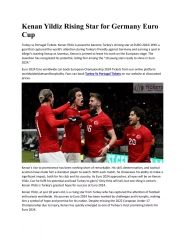
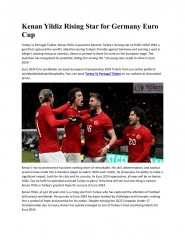
![❤Book⚡[PDF]✔ Star Maps: History, Artistry, and Cartography (Springer Praxis Book](/thumb/21625/book-pdf-star-maps-history-artistry-and-cartography-springer-praxis-book.jpg)


